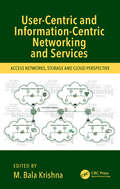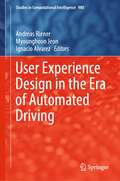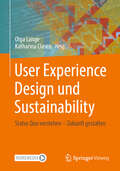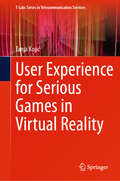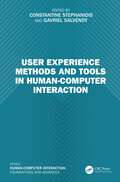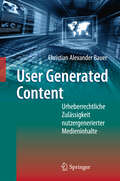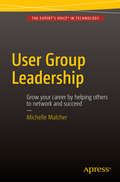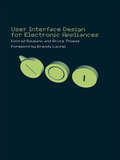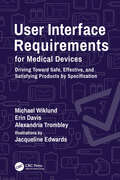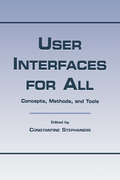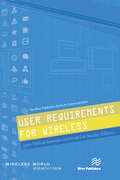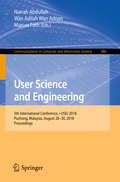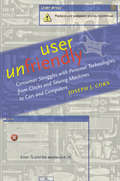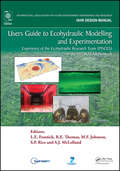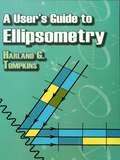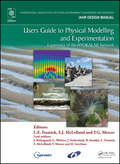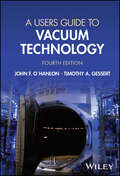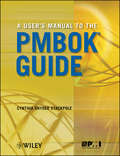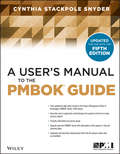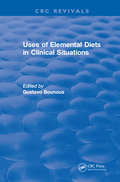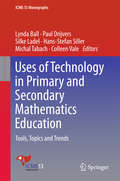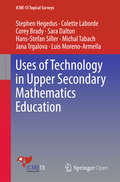- Table View
- List View
User-Centric and Information-Centric Networking and Services: Access Networks, Storage and Cloud Perspective
by M. Bala KrishnaUser-Centric Networks (UCN) and Information-Centric Networks (ICN) are new communication paradigms to increase the efficiency of content delivery and also content availability. In this new concept, the network infrastructure actively contributes to content caching and distribution. This book presents the basic concepts of UCN and ICN, describes the main architecture proposals for these networks, and discusses the main challenges to their development. The book also looks at the current challenges for this concept, including naming, routing and caching on the network-core elements, several aspects of content security, user privacy, and practical issues in implementing UCN and ICN.
User-Centric Networking
by Alessandro Aldini Alessandro BoglioloThis work represents a milestone for the "ULOOP User-centric Wireless Local Loop" project funded by the EU IST Seventh Framework Programme. ULOOP is focused on the robust, secure, and autonomic deployment of user-centric wireless networks. Contributions by ULOOP partners as well as invited tutorials by international experts in the field. The expected impact is to increase awareness to user-centric networking in terms, e. g. , of business opportunities and quality of experience, and to present adequate technology to sustain the growth of user-friendly wireless architectures. Throughout the last 3 years, ULOOP has developed enabling technologies for user-centricity in wireless networks, with particular emphasis on social trust management, cooperation incentives, community building, mobility estimation, and resource management. This work will be of interest to researchers, policymakers, operators, vendors, and end-users interested in the current and future directions of user-centric access networks.
User Design
by Alison A. Carr-ChellmanUser Design offers a fresh perspective on how front-line learners (users) can participate in the design of learning environments. The author challenges the universal assumption that front-line users must be relegated to the role of offering input, and that the actual design activity of learning systems must still be conducted only by experts. The b
User Experience Design in the Era of Automated Driving (Studies in Computational Intelligence #980)
by Andreas Riener Myounghoon Jeon Ignacio AlvarezThis book is dedicated to user experience design for automated driving to address humane aspects of automated driving, e.g., workload, safety, trust, ethics, and acceptance. Automated driving has experienced a major development boost in recent years. However, most of the research and implementation has been technology-driven, rather than human-centered. The levels of automated driving have been poorly defined and inconsistently used. A variety of application scenarios and restrictions has been ambiguous. Also, it deals with human factors, design practices and methods, as well as applications, such as multimodal infotainment, virtual reality, augmented reality, and interactions in and outside users. This book aims at 1) providing engineers, designers, and practitioners with a broad overview of the state-of-the-art user experience research in automated driving to speed-up the implementation of automated vehicles and 2) helping researchers and students benefit from various perspectives and approaches to generate new research ideas and conduct more integrated research.
User Experience Design und Sustainability: Status Quo verstehen – Zukunft gestalten
by Olga Lange Katharina ClasenDieses Buch ist ein Handbuch für alle Gestalter*innen, die mit User Experience (UX) Design mehr zur nachhaltigen Entwicklung von Systemen, Produkten und Dienstleistungen beitragen möchten. Arbeitskreis "Design for Sustainability" der German UPA wurde im Jahr 2023 gegründet und widmet sich allen aktuellen Themen aus dem Bereich UX für Nachhaltigkeit. Als Grundlage für dieses Werk diente eine umfassende Umfrage der UX-Gestalter: innen zum Thema "Design for Sustainability". Somit wurde ein Status Quo erfasst, um die zukunftsweisenden Beiträge und Handlungsempfehlungen für die Zukunft auszuarbeiten. Viel Spaß beim Lesen und Umsetzen!
User Experience for Serious Games in Virtual Reality (T-Labs Series in Telecommunication Services)
by Tanja KojićThe book presents research in understanding how to make Virtual Reality (VR) applications more enjoyable and realistic. The author studies this in relation not just to VR games for entertainment, but also for other applications such as serious games, which are used for education and training. To make VR games better, the work examines topics like the content in the game, the context in which it's played, and human factors like one’s age, and previous experience with VR. By understanding these factors, the author creates guidelines to make VR games more engaging and user-friendly. The primary purpose of this work is to evaluate and identify different influences on User Experience (UX) for VR serious games, intending to narrow the research gap between Influencing Factors (IFs), UX, and design guidelines for VR serious games. With eight user studies and five different VR serious games developed, different influences and links between those factors and UX components are investigated.
User Experience Methods and Tools in Human-Computer Interaction
by Gavriel Salvendy Constantine StephanidisThis book covers user experience methods and tools in designing user‑friendly products and servicesby encompassing widely utilized successful methods, including elicitation, analysis and establishment of requirements, collaborative idea generation with design teams and intended users, prototype testing and evaluation of the user experience through empirical and non‑empirical means.This book• Provides methods and tools tailored for each stage of the design process.• Discusses methods for the active involvement of users in the human‑centered design process.• Equips readers with an effective toolset for use throughout the design process, ensuring that what is created aligns with user needs and desires.• Covers a wide array of research and evaluation methods employed in HCI, from the initiation of the human‑centered development cycle to its culmination.This book is a fascinating read for individuals interested in Human-Computer Interaction research and applications.
User Generated Content
by Christian Alexander BauerDas Web 2.0 hat zu einem Wandel des Nutzerverhaltens in Internet geführt: Immer mehr Nutzer gehen vom passiven Konsum über zu einem interaktiven Nutzungsverhalten. Bei einem Großteil der produzierten Beiträge greifen sie dabei auf fremde, zumeist urheberrechtlich geschützte Inhalte zurück. Vor diesem Hintergrund geht der Autor der Frage nach, inwieweit diese unautorisierte Verwendung fremder Werke und Leistungen urheberrechtlich zulässig ist und in welchem Umfang dieses Phänomen zukünftig vom Gesetzgeber privilegiert werden sollte.
User Group Leadership
by Michelle MalcherThis book is about starting and sustaining a technology user group. User groups are a wonderful way to connect with local and like-minded professionals for networking and learning. All the forums and social media on the internet can't replace face-to-face time spent discussing problems, upcoming technologies, and other pertinent topics. What every user group needs is leaders to organize meetings, find speakers, and connect the community. What every leader needs is good advice and guidance on how to begin a group and nurture new leadership to keep the group sustainable, and Michelle Malcher provides just that right sort of guidance in her book on User Group Leadership. This book is designed to help you understand what goes into starting and building a user group, giving you the tools and resources to do so. Learn what to expect before your first meeting, in the first three months, and in the first year. Malcher has experience from the local group level on up to the international level with the Independent Oracle User Group. If you're involved in technology and are ready to take on a position of leadership by which to help others network, succeed, and grow, then grab a copy of this book. You won't find a better source of guidance for starting and growing a new group on the technology of your choice. Learn what to know before you ever have your first meeting Prepare for each meeting with a list of things that should be done Grow your local members into future leaders What you'll learn Choose the right motivations for starting a group Build a governance structure and integrate with an umbrella group Locate and book interesting speakers Recruit help to share the administrative burden Grow the next generation of leadership Make a difference in people's careers by helping them grow and network and learn Who this book is for User Group Leadership is aimed at technology professionals interested in networking and learning with like-minded people in their same technology area. The book is especially aimed at the ambitious professional who is ready to step into a leadership role by creating a vibrant user community where no such community currently exists, but one is needed. Table of Contents 1. Development of a User Group 2. User Group Governance 3. Building Leaders and Volunteers 4. User Group Planning 5. User Group Members 6. Challenges 7. Career Development 8. From Techie to Leader 9. Qualities of a User Group Leader 10. Qualities of a User Group Volunteer
User Interface Design of Electronic Appliances
by Konrad Baumann Bruce ThomasThis simple and manageable guide to user interface design is written for the professional in industry working on product development and the decision process. It is directed not only to the human factors specialists, but also to technicians, designers, marketing and product managers and students.The book presents guidelines for user interface d
User Interface Requirements for Medical Devices: Driving Toward Safe, Effective, and Satisfying Products by Specification
by Michael Wiklund Erin Davis Alexandria TrombleyThis book is a practical guide for individuals responsible for creating products that are safe, effective, usable, and satisfying in the hands of the intended users. The contents are intended to reduce the number of use errors involving medical devices that have led to injuries and deaths. The book presents the strong connection between user interface requirements and risk management for medical devices and instructs readers how to develop specific requirements that are sufficiently comprehensive and detailed to produce good results – a user-friendly product that is likely to be used correctly. The book’s tutorial content is complemented by many real-world examples of user interface requirements, including ones pertaining to an inhaler, automated external defibrillator, medical robot, and mobile app that a patient might use to manage her diabetes. The book is intended for people representing a variety of product development disciplines who have responsibility for producing safe, effective, usable, and satisfying medical devices, including those who are studying or working in human factors engineering, psychology, mechanical engineering, biomedical engineering, systems engineering, software programming, technical writing, industrial design, graphic design, and regulatory affairs.
User Interfaces for All: Concepts, Methods, and Tools (Human Factors And Ergonomics Ser. #4397)
by Constantine StephanidisUser Interfaces for All is the first book dedicated to the issues of Universal Design and Universal Access in the field of Human-Computer Interaction (HCI). Universal Design (or Design for All) is an inclusive and proactive approach seeking to accommodate diversity in the users and usage contexts of interactive products, applications, and se
User Requirements for Wireless (River Publishers Series In Communications Ser.)
by Lene Tolstrup Sørensen Knud Erik SkoubyIn most IT system development processes, the identification or elicitation of user requirements is recognized as a key building block. In practice, the identification of user needs and wants is a challenge and inadequate or faulty identifications in this step of an IT system development can cause huge problems with the final product. The elicitation of user requirements as such changes according to age groups;, to gender,; to cultural settings,; and into time; and experience in the use of the system/software. User requirements, therefore, cannot be used between projects, IT systems, and different software. That makes the elicitation of user requirements an inherent part of any software development project and a resourceful activity as well. This book provides insights to the process of identifying user requirements and to different types by describing varying case studies in which technologies or software has been developed. A variety of user requirements are provided illustrating the effect of changing the targeted user group with respect to age,; to the context and the different technologies or software as well as to the difference in viewpoint on ways of involving users in the elicitation process. Cases and user requirement elements discussed in the book include: • User requirements elicitation processes for children, construction workers, and farmers• User requirements for personalized services of a broadcast company• Variations in user involvement• Practical elements of user involvement and requirements elicitation• Usable security requirements for design of privacy.
User Science and Engineering: 5th International Conference, i-USEr 2018, Puchong, Malaysia, August 28–30, 2018, Proceedings (Communications in Computer and Information Science #886)
by Natrah Abdullah Wan Adilah Wan Adnan Marcus FothThis book constitutes the refereed proceedings of the 5th International Conference on User Science and Engineering, i-USEr 2018, held in Puchong, Malaysia, in August 2018. The 32 papers accepted for i-USEr 2018 were selected from 72 submissions with a thorough double-blind review process. The selected papers illustrate how HCI is inclusive and omnipresent within the domains of informatics, Internet of Things, Quality of Life, and others. They are organized in the following topical sections: design, UX and usability; HCI and underserved; technology and adoption; human centered computing; HCI and IT infrastructure; and HCI and analytics.
User Unfriendly: Consumer Struggles with Personal Technologies, from Clocks and Sewing Machines to Cars and Computers
by Joseph J. CornWe’ve all been there. Seduced by the sleek designs and smart capabilities of the newest gadgets, we end up stumped by their complicated set-up instructions and exasperating error messages. In this fascinating history, Joseph J. Corn maps two centuries of consumer frustration and struggle with personal technologies.Aggravation with the new machines people adopt and live with is as old as the industrial revolution. Clocks, sewing machines, cameras, lawn mowers, bicycles, electric lights, cars, and computers: all can empower and exhilarate, but they can also exact a form of servitude. Adopters puzzle over which type and model to buy and then how to operate the device, diagnose its troubles, and meet its insatiable appetite for accessories, replacement parts, or upgrades. It intrigues Corn that we put up with the frustrations our technology thrusts upon us, battling with the unfamiliar and climbing the steep learning curves. It is this ongoing struggle, more than the uses to which we ultimately put our machines, that animates this thought-provoking study.Having extensively researched owner’s manuals, computer user-group newsletters, and how-to literature, Corn brings a fresh, consumer-oriented approach to the history of technology. User Unfriendly will be valuable to historians of technology, students of American culture, and anyone interested in our modern dependence on machines and gadgets.
Users Guide to Ecohydraulic Modelling and Experimentation: Experience of the Ecohydraulic Research Team (PISCES) of the HYDRALAB Network (IAHR Design Manual)
by L. E. Frostick R. E. Thomas M. F. Johnson S. P. Rice S. J. McLellandUsers Guide to Ecohydraulic Modelling and Experimentation has been compiled by the interdisciplinary team of expert ecologists, geomorphologists, sedimentologists, hydraulicists and engineers involved in HYDRALAB IV, the European Integrated Infrastructure Initiative on hydraulic experimentation which forms part of the European Community‘s Seventh F
A User's Guide to Ellipsometry (Dover Civil and Mechanical Engineering)
by Harland G. TompkinsThis text on optics for graduate students explains how to determine material properties and parameters for inaccessible substrates and unknown films as well as how to measure extremely thin films. Its 14 case studies illustrate concepts and reinforce applications of ellipsometry -- particularly in relation to the semiconductor industry and to studies involving corrosion and oxide growth.A User's Guide to Ellipsometry will enable readers to move beyond limited turn-key applications of ellipsometers. In addition to its comprehensive discussions of the measurement of film thickness and optical constants in film, it also considers the trajectories of the ellipsometric parameters Del and Psi and how changes in materials affect parameters. This volume also addresses the use of polysilicon, a material commonly employed in the microelectronics industry, and the effects of substrate roughness. Three appendices provide helpful references.
Users Guide to Physical Modelling and Experimentation: Experience of the HYDRALAB Network (IAHR Design Manual)
by L. E. Frostick S. J. McLelland T. G. MercerA Users Guide to Hydraulic Modelling and Experimentation provides a systematic, comprehensive summary of the progress made through HYDRALAB III . The book combines the expertise of many of the leading hydraulic experimentalists in Europe and identifies current best practice for carrying out state-of-the-art, modern laboratory investigations. In add
A User's Guide to the Age of Tech (Electronic Mediations)
by Grant WythoffHow users experience and influence technological change—when so much of that change feels out of our control Every day, we casually employ one of the most complex tools ever created, using it to read the news, plan our day, and connect with friends. In A User&’s Guide to the Age of Tech, Grant Wythoff investigates the process by which now-ubiquitous technologies like our phones become integrated into our lives, showing how the &“gadget&” stage—before devices are widely adopted—opens the door for users to co-create these technologies and adapt them toward unexpected ends. In this elegant, approachable work, Wythoff offers a view of how users make new technology their own, subverting dominant power structures and imagining uses never intended by their creators. Rooted in a detailed look into the history of technique (focusing on how we do things with tools rather than the tools themselves), A User&’s Guide to the Age of Tech proceeds to complicate, and influence, discussion of subjects like the digital divide and AI. Drawing on a range of sources, including novels, patents, and newspapers, Wythoff explores the vernacular philosophies that have emerged from users and their diverse, everyday practices, bringing down to earth the conversation about digital titans, away from the abstracted domains of server farms and algorithms. Lodging a passionate argument that we know ourselves better than the data brokers who appear to wield influence over our psyches, Wythoff invites readers (and tech users) to imagine their own digital technique, acknowledge their vast expertise, and see its immense value. Retail e-book files for this title are screen-reader friendly with images accompanied by short alt text and/or extended descriptions.
A Users Guide to Vacuum Technology
by John F. O'Hanlon Timothy A. GessertA USERS GUIDE TO VACUUM TECHNOLOGY Choose and understand the vacuum technology that fits your project’s needs with this indispensable guide Vacuum technology is used to provide process environments for other kinds of engineering technology, making it an unsung cornerstone of hundreds of projects incorporating analysis, research and development, manufacturing, and more. Since it is very often a secondary technology, users primarily interested in processes incorporating it will frequently only encounter vacuum technology when purchasing or troubleshooting. There is an urgent need for a guide to vacuum technology made with these users in mind. For decades, A User’s Guide to Vacuum Technology has met this need, with a user-focused introduction to vacuum technology as it is incorporated into semiconductor, optics, solar sell, and other engineering processes. With an emphasis on otherwise neglected subjects and on accessibility to the secondary user of vacuum technology, it balances treatment of older systems that are still in use with a survey of the latest cutting-edge technologies. The result promises to continue as the essential guide to vacuum systems. Readers of the fourth edition of A User’s Guide to Vacuum Technology will also find: Expanded treatment of gauges, pumps, materials, systems, and best??operating practices Detailed discussion of cutting-edge topics like ultraclean vacuum and contamination control An authorial team with decades of combined research and engineering experience A User’s Guide to Vacuum Technology is essential for those entering emerging STEM programs, engineering professionals and graduate students working with a huge range of engineering technologies.
A User's Manual to the PMBOK Guide
by Cynthia StackpoleThe professional standard in the field of project management, A Guide to the Project Management Body of Knowledge better known as the PMBOK® Guide published by the Project Management Institute (PMI) serves as the ultimate resource for professionals and as a valuable studying and training device for students taking the PMP® exam. A User's Manual to the PMBOK® Guide takes the next logical step to act as a true user's manual. Its accessible format and easy-to-understand language helps to not only distill essential information contained in the PMBOK® Guide--Fourth Edition, but also fills an educational gap by offering instruction on how to apply its various tools and techniques. This book: * Defines each project management process in the PMBOK® Guide--Fourth Edition, describes their intent, and discusses their individual ITTOs (inputs, tools and techniques, and outputs) * Features examples, handy tips, and sample forms to supplement learning * Is written by the author who was project manager of the PMBOK ®Guide--Fourth Edition * Contains a data flow diagram of each process in the PMBOK® Guide--Fourth Edition to show how information is distributed A User's Manual to the PMBOK® Guide simplifies the PMBOK® Guide--Fourth Edition to provide the springboard from which successful project management processes are interpreted and carried out in the real world. Thorough in coverage and rich in content, this manual is a worthy companion to augment the important strategies laid out in the PMBOK® Guide Fourth Edition--and the one book that aspiring or professional project managers should never be without.
A User's Manual to the PMBOK Guide
by Cynthia Snyder StackpoleThe must-have manual to understand and use the latest edition of the Fifth Edition The professional standard in the field of project management, A Guide to the Project Management Body of Knowledge (PMBOK® Guide—Fifth Edition) published by the Project Management Institute (PMI®) serves as the ultimate resource for professionals and as a valuable studying and training device for students taking the PMP® Exam. A User's Manual to the PMBOK® Guide takes the next logical step to act as a true user's manual. With an accessible format and easy-to-understand language, it helps to not only distill essential information contained in the PMBOK® Guide—Fifth Edition, but also fills an educational gap by offering instruction on how to apply its various tools and techniques. This edition of the User's Manual: Defines each project management process in the PMBOK® Guide—Fifth Edition, describes the intent, and discusses the individual ITTOs (inputs, tools and techniques, and outputs) Features examples, handy tips, and sample forms to supplement learning Contains a data flow diagram of each process in the PMBOK® Guide—Fifth Edition to show how information is distributed Is updated to provide deeper coverage of stakeholder management and to include new processes for scope, schedule, cost, and stakeholder management The User's Manual enables you to put the PMBOK Guide—Fifth Edition to work on your projects. It will help you implement the processes described in the PMBOK Guide—Fifth Edition and apply the tools and techniques to help make your projects successful. Thorough in coverage and rich in content, it is a worthy companion to augment the important strategies laid out in the PMBOK® Guide—Fifth Edition, and the one book that aspiring or professional project managers should never be without. Fully updated to align with A Guide to the Project Management Body of Knowledge (PMBOK® Guide)–Fifth Edition Describes how to apply tools and techniques for projects and how to create process outputs Presents information by process group Expands upon the PMBOK® Guide with information on the sponsor's role and planning loops Integrates and describes interpersonal skills into the process where they are identified (PMBOK, PMI, PMP and Project Management Professional are registered marks of the Project Management Institute, Inc.)
Uses of Elemental Diets in Clinical Situations
by G. BounousThe studies presented in this book demonstrate that a new concept in the management of carious intestinal disorders should be considered, namely, that common nutrients may protect or heal the mucosa by virtue of the particular form and mode in which they are delivered to the intestinal lumen and their availability to the mucosal cells. The substitution of intact protein in the formula by hydrolysate appears to me an important factor.
Uses of Technology in Primary and Secondary Mathematics Education: Tools, Topics And Trends (ICME-13 Monographs)
by Paul Drijvers Lynda Ball Hans-Stefan Siller Silke Ladel Michal Tabach Colleen ValeThis book provides international perspectives on the use of digital technologies in primary, lower secondary and upper secondary school mathematics. It gathers contributions by the members of three topic study groups from the 13th International Congress on Mathematical Education and covers a range of themes that will appeal to researchers and practitioners alike. The chapters include studies on technologies such as virtual manipulatives, apps, custom-built assessment tools, dynamic geometry, computer algebra systems and communication tools. Chiefly focusing on teaching and learning mathematics, the book also includes two chapters that address the evidence for technologies’ effects on school mathematics. The diverse technologies considered provide a broad overview of the potential that digital solutions hold in connection with teaching and learning. The chapters provide both a snapshot of the status quo of technologies in school mathematics, and outline how they might impact school mathematics ten to twenty years from now.
Uses of Technology in Upper Secondary Mathematics Education
by Stephen Hegedus Colette Laborde Corey Brady Sara Dalton Hans-Stefan Siller Michal Tabach Jana Trgalova Luis Moreno-ArmellaThis survey addresses the use of technology in upper secondary mathematics education from four points of view: theoretical analysis of epistemological and cognitive aspects of activity in new technology mediated learning environments, the changes brought by technology in the interactions between environment, students and teachers, the interrelations between mathematical activities and technology, skills and competencies that must be developed in teacher education. Research shows that the use of some technologies may deeply change the solving processes and contribute to impact the learning processes. The questions are which technologies to choose for which purposes, and how to integrate them, so as to maximize all students' agency. In particular the role of the teacher in classrooms and the content of teacher education programs are critical for taking full advantage of technology in teaching practice.
